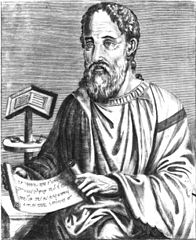
An Ecclesiastical History To The 20th Year Of The Reign Of Constantine by Eusebius
CHAPTER XVIII
THE STATUE ERECTED BY THE WOMAN HAVING AN HEMORRHAGE
BUT as we have mentioned this city, I do not think it right to pass by a narrative that deserves to be recorded for posterity. They say that the woman who had an issue of blood, mentioned by the evangelists, and who obtained deliverance from her affliction by our Saviour, was a native of this place, and that her house is shown in the city, and the wonderful monuments of our Saviour’s benefit to her are still remaining. At the gates of her house, on an elevated stone, stands a brazen image of a woman on her bended knee, with her hands stretched out before her like one entreating. Opposite to this there is another image of a man erect, of the same materials, decently clad in a mantle (διπλοιδα), and stretching out his hand to the woman. Before her feet, and on the same pedestal, there is a certain strange plant growing, which, rising as high as the hem of the brazen garment, is a kind of antidote to all lands of diseases. This statue, they say, is a statue of Jesus Christ, and it has remained even until our times; so that we ourselves saw it whilst tarrying in that city. Nor is it to be wondered at, that those of the Gentiles who were anciently benefited by our Saviour, should have done these things, since we have also seen representations of the apostles Peter and Paul, and of Christ himself, still preserved in paintings; as it is probable that, according to a practice among the Gentiles, the ancients were accustomed to pay this kind of honour indiscriminately to those who were saviours to them.
Copyright ©1999-2023 Wildfire Fellowship, Inc all rights reserved

 Keep Site Running
Keep Site Running